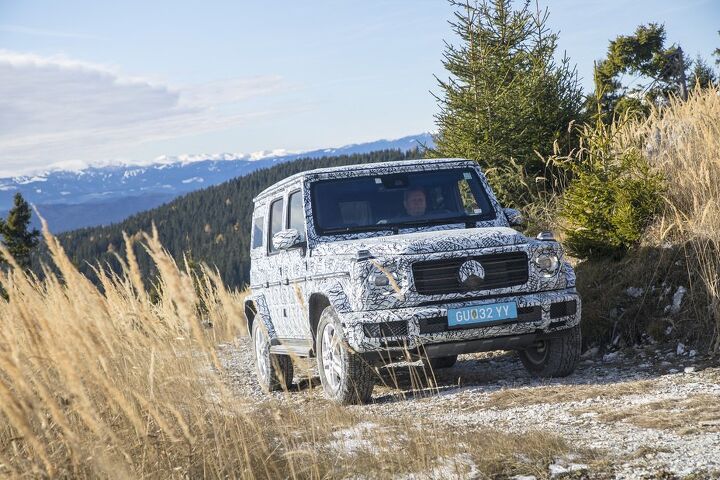#G-wagon
Rare Rides: The Awfully Expensive Mercedes-Maybach G 650 Landaulet, From 2018
Today’s Rare Ride joins the exclusive club of ultra-expensive V12 SUVs presented in this series. Thus far, the population was one: the Lamborghini LM002.
Today we take a look at a limited-run SUV that Mercedes made as expensive and gauche as humanly possible.
Mercedes-Benz Announces Electric G-Class
Sascha Pallenberg, Daimler’s Head of “Digital Transformation,” shared a quote from CEO Ola Källenius issued at this year’s Automobilwoche Kongress, saying Mercedes-Benz is planning to manufacture an electric G-Class.
“There will be a zero-emission EV version of the Mercedes-Benz G-Class. In the past there were discussions whether we should eliminate the model, the way I see things now I’d say the last Mercedes to be built will be a G-Class,” Källenius said.
Using current battery technologies, this seems idiotic. The G-Class already outweighs pretty much every EV on the market this author can think of and it’s only going to get heavier once it’s lugging around a gigantic battery pack. The lightest G-Wagon tips the scales at 5,550 pounds. Another thousand wouldn’t be out of the question if Daimler expects it to have a truly competitive range. The model is just too heavy and has the aerodynamics of an open parachute.
Can't Afford a Mercedes-AMG G63? Convert a New Suzuki Jimny Into One Instead
A brand new Mercedes-AMG G63 isn’t what we’d call cheap, if you can even get one. The luxury off-road monster can literally go anywhere in a style uniquely its own, but it’s big, pricey and not the most fuel efficient. So what if you want a G63 but want to get it on the cheap? You build your own out of a Suzuki Jimny.
The Jimny is the darling of forbidden fruit. It’s the opposite of the Mercedes. It’s inexpensive, frugal and small. It’s off-road prowess comes from determination and grit instead of horsepower and torque. But it is boxy like the G-Wagon. So that counts for something.
Mercedes-Benz Cast a 1979 280GE in Synthetic Amber for NAIAS
In celebration of the redesigned G-Class, Mercedes-Benz has decided to cast the original G-Wagen in fake amber. The massive instillation is suppose to convey the timelessness of the SUV’s design — which is good, because we don’t think Daimler is going to bother changing the look of the new one all that much.
“The amber cube puts the uniqueness of the G-Class in a nutshell” explained Dr Gunnar Güthenke, head of Mercedes-Benz’s off-road vehicle unit. “Our cult off-road vehicle has been continuously evolving for nearly 40 years – without losing its character or its core values. Its DNA is stronger than time and than any fashion trend. The cube expresses this to stunning effect and thus embodies the objective for advancing the G-Class.”
2019 Mercedes-Benz G-Class Assured to Be Off-road Ready
There’s been a lot of buzz around the 2019 Mercedes-Benz G-Class, details of which “leaked” earlier this week. However, as the vast majority of those tidbits came straight from the manufacturer, Benz is really just whetting appetites for its updated SUV ahead of its official debut at the Detroit Auto Show in two weeks.
The good news is that Mercedes doesn’t seem to have muddled the G-Class’ iconic design; the bad news is that the company feels compelled to address concerns that the SUV won’t be a genuine off-road vehicle. Considering that I’ve never seen anyone but automotive journalists take the ultra-lux behemoth through the dirt, this didn’t seem like a problem that needed to be confronted.
Still, Benz does intend for the G-Class to journey across treacherous terrain, and there’s evidence to back up its claims.
QOTD: Land Rover Defender Vs. Mercedes-Benz G-Wagon – Pick Your Poison
Let’s say you had around $50,000 to spend on a vehicle purely as an indulgence. In this indulgence, you desire a somewhat rare SUV that’s basic, yet carries substantial prestige. In the same way, your SUV of choice would be very capable off-road, but you’d never take it there (as it’s simply too valuable). This vehicle would be for around-town jaunts on sunny days only.
A tough and specific decision for you, as imaginary well-heeled buyer of this used SUV. But never fear, as we’ve narrowed the choices down to two for today’s QOTD.
So, between the Land Rover Defender and Mercedes-Benz G-Wagon, which do you choose to lighten your wallet?
The Mercedes-Maybach G650 Landaulet: Earth's Most Unnecessary Vehicle
Few vehicles offer the snob appeal and image enhancement of the Mercedes-Benz G-Class, but seriously wealthy Benz buyers interested in comfort are going to hire a private driver and purchase something with a Maybach badge. Of course, that limits them to a tarted-up S-Class, or so it was before the introduction of the G650 Landaulet — which is, quite possibly, the dumbest vehicle currently entering production.
While the Landaulet’s forward-most occupants are treated to the nice but relatively unchanged interior from the G-Class, the rear is an extravaganza of luxury to be enjoyed in or out of the elements. Much like the Mercedes-Maybach S650 Cabriolet, it is a convertible. Unlike the Cabrio, however, the only person to benefit from the folding top is the multi-millionaire riding in the back.
2016 Mercedes-Benz G-Class - New Engine Candy, Same Old Boxy Wrapper
As Mercedes-Benz rolls out its all-new 4.0-liter V8, engineers in Stuttgart have decided the bi-turbo mill will fit right at home in the aging Gelandewagen, a luxo-utility military-born vehicle that hasn’t seen a major update in 25 years.























Recent Comments